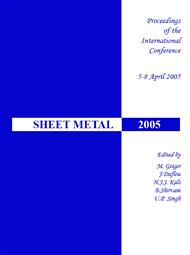p.753
p.763
p.771
p.779
p.787
p.795
p.805
p.809
p.817
Modelling and Analysis of Integrated Hotforming and Quenching Processes
Abstract:
In the automotive industry a general tendency to choose steels with enhanced strength for structural parts can be observed. This trend results from the increased lightweight design efforts to satisfy the fleet consumption restrictions. Hot forming and quenching of boron steel offers the possibility to improve the component strength and reduce the weight of structural parts. The main influences on the process are described and a method to model and simulate this process using the finite element method using LS-DYNA is presented. Experimental investigations of the contact heat transfer have been carried out to enhance the simulation accuracy. A prototyping tool of a structural part is used to examine the process under production conditions. Temperatures of the tool and the part are measured during the process. These temperatures are compared with the simulation results in order to reevaluate the results of the process simulation.
Info:
Periodical:
Pages:
787-794
Citation:
Online since:
May 2005
Keywords:
Price:
Сopyright:
© 2005 Trans Tech Publications Ltd. All Rights Reserved
Share:
Citation:


